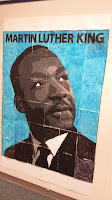 |
| "The Gardener" (1882-3), Seurat |
Many areas of the sciences use art to visually convey information and teach subject matter. What a scientist may see under a microscope can be converted to stipple drawings. Scientific illustration (of plants, insects, microscopic images, microbes & viruses, wormholes, etc.) can be a career in which an artist's skills may be employed. It's fun to explore the microscopic patterns in nature. Learning to recognize a pattern and using repetition are skills an artist uses to create interest. The artwork of Kehinde Wiley is a great example. Georges Seurat and other Pointillists used colored dots placed adjacent to each other to create light and allow our brains to blend the colors together when viewed from far away. This technique is also called divisionism (chromoluminarism).
You may need to study Anatomy to be able to draw figures accurately. Like creating a sculpted figure you would start with the armature (the bones) to understand the proportional size. The muscles begin to add form and the skin the outside texture. Learning to draw can be a valuable skill.

Architecture is like studying the anatomy of a building. From the girders and studs to the interior drywall and exterior siding and roofing. Drafting is both an art and a profession. This kind of drawing requires an understanding of perspective. Magnetic building tiles purchased online are wonderful toys for kids to learn the anatomy of buildings using geometric shapes in attractive colors. Yesterday, we babysat a pair of friends' kids who absolutely loved erecting buildings. What amazed me was how instead of making the traditional tower this child made an actual floor of a building complete with rooms.

Check out the Dali Museum in Florida. The large free-form geodesic glass bubble known as the “enigma” is made up of 1,062 triangular pieces of glass, stands 75 feet at its tallest point, a 21st-century homage to the dome of his museum in Costa Brava, Spain. Inside you'll find a helical staircase – recalling Dali’s obsession with spirals and the double helical shape of the DNA molecule.

I don't like it when people say, "Oh, I can't even draw a straight line." Lines don't have to be straight, but if they do, you could always use a ruler. Kids need to learn how to use rulers not only for making straight lines but also for measuring. I like to do enlargement exercises with students so that they may learn about proportion using measurement and multiplication. For Valentine's Day one year, we took a poster-sized picture of Elvis Presley and divided it up into enough pieces for the class to blow it up to three times the size. A parent helper then turned it into a bulletin board (another fun group project). Years later my Kent school did something similar for Martin Luther King Day.

Photography is an art, and some artists like Johannes Vermeer used camera obscura to aid in laying out his painted scenes before the camera was invented. Someone like Norman Rockwell had the luxury of using a camera to capture his subjects.
The art of illusion is pretty much what allows artists to create paintings and make them look three-dimensional. Shape & Form (spatial reasoning) – how to define forms and create the illusion of space. Artists also use the element of space and associated principles to create depth. Light & Shading show where light is coming from and how shadows are formed based on time of day. Next time you view a landscape see if you can surmise the time of day when the artist painted it.


Artists like:
M.C. Escher,
Salvador Dali,
Georges Seurat,
Victor Vasarely,
and Johannes Vermeer,
were masters of illusion.
No comments:
Post a Comment
Do you have a favorite art movement or style? What's your favorite abstract artwork?